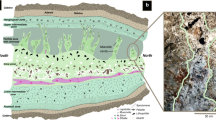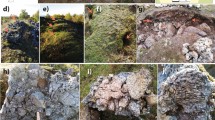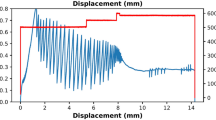Abstract
As crystals grow from solution they may trap small amounts of the solvent and other solutes. It has long been known that minerals evolve gases on heating1–4 and it has been assumed that, except for alteration during weathering, the gases are incorporated from the growth medium at the time of crystallisation. If the amount and composition of the gases trapped in minerals are to be used to make detailed geological interpretations it is essential that the location of the gas within the crystal structure is established. In minerals like carbonates and hydrates, ‘gases’ form part of the structure. Sites in which gas can occur include primary and secondary fluid inclusions, point defects, lattice dislocations, grain boundaries, and structure holes. Gas can also be adsorbed on crystal surfaces. Each site has its own characteristic temperature at which gas loss occurs, so that on heating a mineral the gases are released at different temperatures. This provides a method for distinguishing between gases from different sites.
This is a preview of subscription content, access via your institution
Access options
Subscribe to this journal
Receive 51 print issues and online access
$199.00 per year
only $3.90 per issue
Buy this article
- Purchase on Springer Link
- Instant access to full article PDF
Prices may be subject to local taxes which are calculated during checkout
Similar content being viewed by others
References
Chamberlin, R. T., Carnegie Institute of Washington, Publ. 106 (1908).
Shepherd, E. S., Am. J. Sci., fifth ser., 35 A, 311 (1938).
White, D. E., and Waring, G. A., Prof. Pap. US geol. Surv., 440 -K (1963).
Roedder, E., Prof. Pap. US geol. Surv., 440 -JJ (1972).
Barker, C., and Sommer, M. A., in Analytical Methods Developed for Application to Lunar Samples Analyses, 56–70 (American Society for Testing Materials, Publication STP 539, 1973).
Van Vlack, L. H., Material Science for Engineers (Addison-Wesley, London, 1971).
Ballman, A. A., Laudise, R. A., and Rudd, D. W., Appl.Phys.Lett., 8, 53 (1966).
Ingerson, E., Am. Miner., 32, 375 (1947).
Skinner, B. J., Econ. Geol., 48, 541 (1953).
Author information
Authors and Affiliations
Rights and permissions
About this article
Cite this article
BARKER, C., SOMMER, M. Potential method of geobarometry using quartz. Nature 250, 402–404 (1974). https://doi.org/10.1038/250402a0
Received:
Revised:
Issue Date:
DOI: https://doi.org/10.1038/250402a0
Comments
By submitting a comment you agree to abide by our Terms and Community Guidelines. If you find something abusive or that does not comply with our terms or guidelines please flag it as inappropriate.



